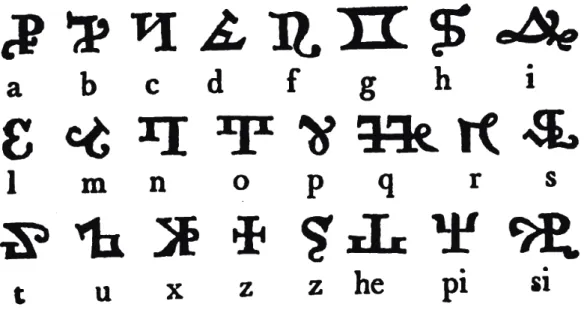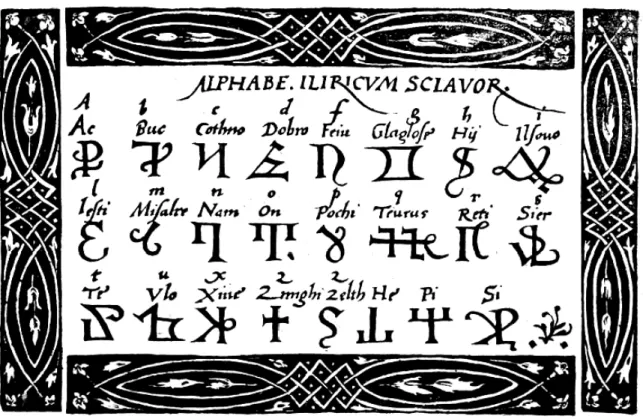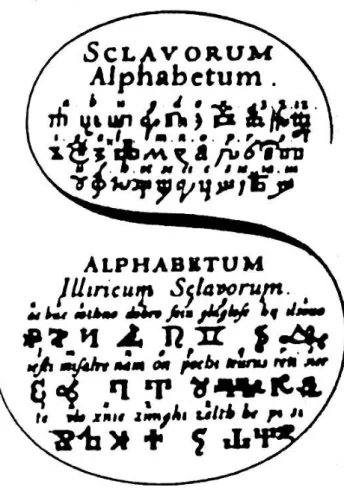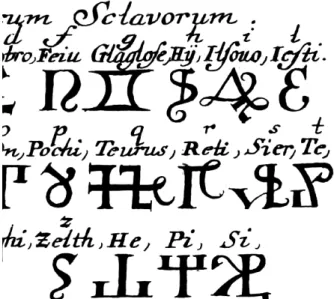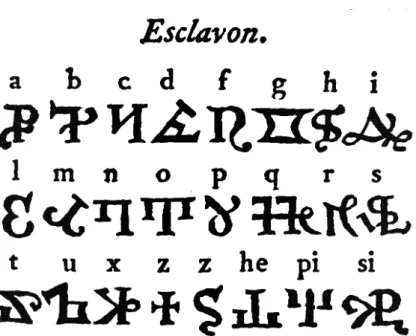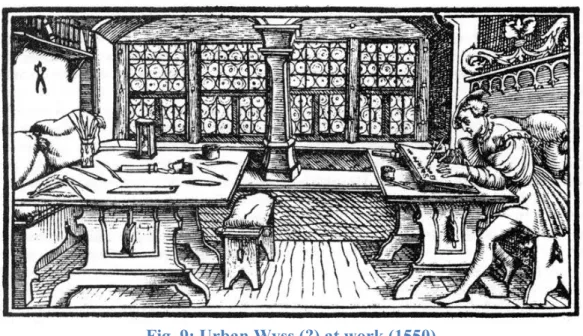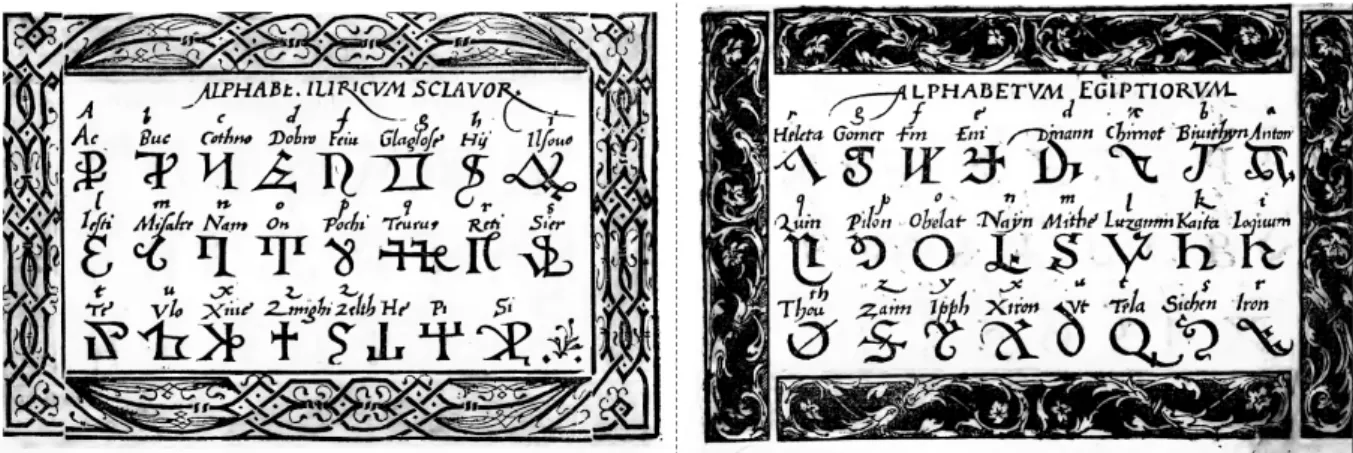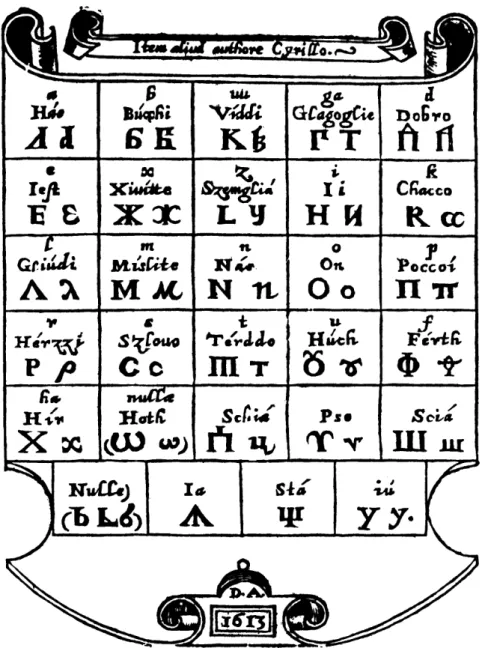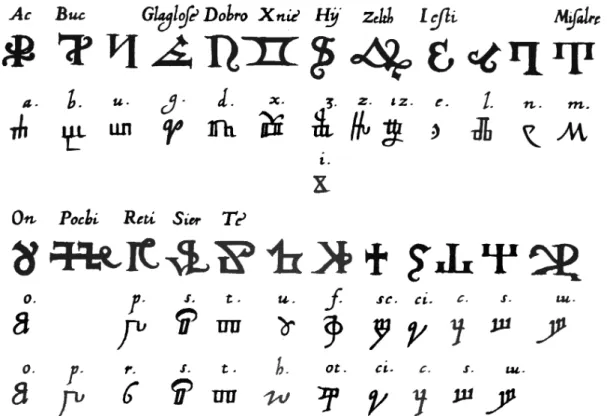Sebastian Kempgen: The Mysterious Illyrian Slavic Alphabet
The Mysterious “Alphabetum Iliricum Sclavorum”
Sebastian Kempgen
1. Everybody knows that there are two Slavic alphabets, i.e. alphabets invented for the use by the Slavs, namely Glagolitic and Cyrillic. Other alphabets are being used (Latin) or have been used by in Slavic countries for writing Slavic, notably Greek and Arabic. However, in some medieval typographic manuals and books reproducing foreign or exotic alphabets from around the world there is a mysterious third Slavic alphabet to be found. It is different from both Glagolitic and Cyrillic, is said to be unknown1, has no name of its own besides being described as “Iliricum Sclavorum” or simply “Sclavonian”. It looks like this:
Fig. 1: The “Illyrian Slavic Alphabet”
In this paper, we would like to shed some light on this alphabet which seems to have been neglected or overlooked in manuals or papers on Slavic paleography, and its origins. In this way, it is a extension to the paper by Roland Marti (1995) whose subject are textual sources with alphabets added to them rather than collections of alphabets as such.
2. The oldest sample which we could find is in the book “Libellus valde doctus, elegans, &
utilis…” by Urban Wyss, published in Zurich in 1549. As its name implies, it is a book aimed primarily at calligraphers showing many samples of Latin handwriting, but also to readers who want to learn more about foreign alphabets. In this book, the Illyrian Slavonic alphabet, cut in wood, is the only (!) Slavic alphabet to be shown. Below is a reproduction of the alphabet, touched up by the author (as have been all others in this paper for the best print- ing in black and white). A second edition of the book, published in 1564, reprints the same alphabet, set in another frame.
1 For example, by blogger Ulliana_Art (s.a.) – one of only two online sources to mention the alphabet. However, the blogger does not seem to know that “Sclavor.” is the abbreviation for
“Sclavorum” (Gen. Pl.) or that in “Alphabetv̄” the superscipt stands for the “m”, so that the word reads “Alphabetum”, not “Alphabetu”.
Sebastian Kempgen 2
Fig. 2: Wyss, Alphabetum Iliricum Sclavorum (1549)
3. During the same time in Italy, the famous typographer Palatino devotes three pages of his book to Slavic alphabets. The book was published in Rome in 1550, but many of the tables were created in 1545. Palatino’s first figure shows a (Croatian) Glagolitic alphabet which he attributes to St. Hieronymus, the second figure a Cyrillic alphabet attributed to St. Cyrill, and the third one a text in Bosnian Cyrillic – possible the oldest specimen of printed Bosnian Cy- rillic. The mysterious Illyrian Slavic is not among them. The same holds true for Postel’s book “Linguarum duodecim characteribus…”, published in 1538.
Fig. 3: de Bry, Alphabetum Iliricum Sclavorum (1596)
The Mysterious Illyrian Slavic Alphabet 3
4. 50 years after Wyss, the mysterious alphabet is included in “Alphabeta et Characteres”
published by the brother de Bry in Frankfurt in 1596, this time along with other Slavic alpha- bets: Croatian Cyrillic and Glagolitic alphabets, an Old Church Slavonic Cyrillic alphabet, the Illyrian alphabet combined with a cursive Glagolitic alphabet on another plate – see fig. 3 above –, and another Croatian Glagolitic alphabet combined with a “Moscovitian” Cyrillic alphabet on one plate. The Illyrian alphabet is exactly the same as the one from Wyss, though the actual letters differ slightly. Thus, it has travelled from Switzerland to Germany, but the de Brys obviously had other sources available to them as well.
5. Only a dozen years later in France Claude Duret publishes his “Thresor [sic] de L’Histoire des Langves de cest vnivers” (1613). He does include several Slavic alphabets in his work: a Serbian Cyrillic one, a Dalmatian and an Illyrian one (which are both Croatian Glagolitic), and another Cyrillic alphabet (with Bosnian traits). The Illyrian alphabet from Wyss is not included.
6. The Illyrian alphabet makes its next appearance fifty years later in Daniel’s Copy-Book, published in London in 1664 by Richard Daniel, with engravings by Edward Cocker. It is presented along with the Glagolitic alphabet in one figure (see below)2. Again, the alphabet is the same as before. By now, the alphabet had travelled north from Zurich to Frankfurt, and from there to London.
Fig. 4: Daniel’s Alphabetum Illiricum Sclavorum (1664)
2 The picture was taken from Žubrinić (1995) because the online edition of Daniel (1664) misses p. 50 which should contain the Slavic alphabets shown above.
Sebastian Kempgen 4
7. Nearly 80 years later, in 1740, the alphabet was included in Geßner’s manual on printing (“Buchdruckerkunst und Schriftgießereÿ”), published in Leipzig, Germany. Only one half of the table has been digitized due to some laziness during the scanning process3 but it is obvi- ous, that it is indeed the same alphabet. Geßner often refers to de Bry, so his source is clear.
Besides this Illyrian alphabet, Geßner has tables for Cyrillic, Illyrian Glagolitic, Croatian Glagolitic, and Russian (Cyrillic).
Fig. 5: Geßner, Illyricum Sclavorum (1740)
Fig. 6: Fritz, Alphabetum Sclavorum (1743)
3 In this book, some of the alphabets are on large-format tables which have not been unfolded during the scanning process.
The Mysterious Illyrian Slavic Alphabet 5
8. Around the same time, in 1743, Johann Friedrich Fritz included the alphabet in his calli- graphic manual and collection of alphabets (p. 75), and the same alphabet can again be found in his “Orientaliſch- und Occidentaliſcher Sprachmeiſter” (Fritz & Schulze 1748, 149). The al- phabet is the same as before. – In these books, the Sclavonian Alphabet is printed in one long row as part of a table. To save some space, we will reproduce it here in two rows (see above, fig. 6).
9. A few years later, the well-known French typographer Pierre Simon Fournier includes
“Esclavon” in the Slavic alphabets in his “Manuel typographique” (1766, table 69). He does not continue the tradition of printing the characters’ names, just the Latin equivalent. This seems to be the first appearance of the Illyrian Slavonic alphabet in France after having been printed in Switzerland, Germany, and England before. In the same year in Italy, Grubissichio does not mention this alphabet in his book on the origins of the Glagolitic alphabet (“In origi- nem et historiam alphabeti sclavonici glagolitici vulgo hieronymiani…”).
Fig. 7: Fournier, Esclavon (1766)
Fig. 8: Fry, Sclavonian (1799)
Sebastian Kempgen 6
10. Last but not least, in 1799, the mysterious alphabet shows up in Edmund Fry’s “Pan- tographia”, as one of ten samples of Slavic alphabets. He calls it “Sclavonian” and states (p.
267): “Many nations, both in Europe and Asia, speak this language; it is used generally in all the eastern parts of Europe, except Greece, Hungary, and Wallachia; but these nations have a variety of characters. – Fourn. v. 2. p. 226.” He is the only one to explicitly name his source but has nothing to contribute to the alphabet in question.
11. Let us sum up our findings: We have a mysterious Slavic alphabet, called mostly “Iliri- cum Sclavorum”, with typographic evidence from the 16th right up to the end of the 18th cen- tury. So far, seven books on typography, printing and languages are known to show this al- phabet. The oldest specimen was printed in 1549, the last book to show it (as far as we know) was published in 1799. In the 19th century it seems to have been forgotten or brushed aside, at a time when Slavic philology began to emerge and knowledge of Glagolitic and Cyrillic (es- pecially Glagolitic) became more sound, the priority of Glagolitic over Cyrillic was proven, and St. Hieronymus no longer believed to be one of its authors. The alphabet appears in Swit- zerland first, then travels north to Germany where it is reprinted several times, and from Ger- many it moves onwards to London, and later to France. There is no evidence for this alphabet in Italy neither from Venice nor from Rome where most printing occurred at the time.
There are some obvious peculiarities in these alphabets which nevertheless do not seem to have been noticed before, so we would like to point them out here:
• In all of these alphabets, the number and shape of the letters are identical, with no variation at all. (The actual letters on the engravings differ slightly.) This is in stark contrast to the figures for Cyrillic and Glagolitic alphabets in the same books in which the characters vary in number and shape during the centuries.
• In all the alphabets the names of the letters are identical, too, except for some slight ortho- graphic variation. (They were not reproduced anymore at the end of the 18th century.) Again, this is not the case with the other two Slavic alphabets. The order of the letters are of the ‘Latin’ ABC type.
• The name of the alphabet is identical in all sources, too (except for straight translations).
These findings alone are proof enough that there has only ever been exactly one blueprint for this mysterious Slavonic alphabet, the original engraving by Wyss in 1549, which all other authors later copied, taking it for a real alphabet. These later copies reproduced the alphabet very faithfully, but is is obvious that, for 250 years, none of the authors of these copybooks had a “living” alphabet to check his engravings against, that there actually were no texts that could be used to sample these letters from, no speakers to correct anything etc. Whereas in all these typographic books the Glagolitic and the Cyrillic alphabets do exhibit certain changes over time as they changed naturally, this one alphabet seems to be frozen in time, as if it had been photocopied by one author after the other.
What is also very telling is that the alphabet appears “on the periphery” only, so to speak – north of the Alps, away from any Slavic-speaking country. Palatino, publishing about the same time as Wyss in Rome, knows nothing about the mysterious alphabet, neither does Gru- bissichio. Its later appearance is restricted to Germany, England, and France, while in Italy we only find the “real” Slavic alphabets.
12. If the alphabet in question can indeed be traced back to Urban Wyss and his publication in 1549 in Zurich, then it is worth to have a closer look at the author.
The Mysterious Illyrian Slavic Alphabet 7
Wyß (alternate spelling: Wyss) was a teacher, calligrapher and type cutter, working in Bern and having his publications printed in Zurich, Switzerland. Although the Wyss were well- known citizens of Bern and their grandchildren live there until this day, it remains unknown exactly when Urban Wyss was born or when he died. It is assumed that he was born around 1530 and had two children.4
Fig. 9: Urban Wyss (?) at work (1550)
More is known about the influential and widely successful printing house that published his works, Froschauer. These printers published more than a thousand books, mainly in German and Latin. Foreign language editions, among which especially Hebrew could be expected, were rare. At the time when Wyss cut his wooden blocks, this printing house regularly sent someone to Venice, Europe’s “capital of printing” at the time, to buy all the latest books.5 Thus, it can be assumed that the sources that Wyss had available to himself came from Venice.
It is also worth having a closer look at the other alphabets that Wyss cut for his book. Its ap- pendix contains tables for the following alphabets: Græcum, Hebrai[cum], Indicum, Arabum, Siriorum, Saracenorum, Sclavorum, Egiptiorum, and Caldaicum Antiquum.
From a typographic point of view, these alphabets all follow the same design and look very similar to each other. In other words, Wyss, working on wood, cut all of these alphabets in a similar vein, not trying to preserve any different designs which he might have seen in his sources. In today’s terms, it is a serifed “Roman” design he applied to all alphabets.
4 See http://www.bernergeschlechter.ch/humo-gen/family.php?database=humo_&id=F27685
&main_person=I80589. The illustration has been taken from his second book (1550).
5 See Leu (2004) for more information.
Sebastian Kempgen 8
Fig. 10: Two alphabets from Wyss
13. The Latin equivalents and the character names in Wyss’ alphabet deserve special attention.
These are the Latin letters: a – b – c – d – f – g – h – i – l – m – n – o – p – q – r – s – t – u – x – z – z – Ø – Ø – Ø. They follow the “Latin” order (abcd), not the “Greek” order (abvg). This order has some astonishing defects: there is no < e >, which is such a basic sound and letter, and the < k > is missing, too. It is hard to imagine a Slavic alphabet having neither of these two sounds.
The names of the characters do have similarity to the usual Slavonic names Az Buki Vedi etc., but only partly. It is these Slavic names of the character that serve as an indication that we are dealing with a Slavic alphabet in the first place – otherwise one could not even be sure. This is the row of names by itself: Ac – Buc – Cothno – Dobro – Feiu – Glagloſe – Hij – Ilſouo – Ieſti – Miſalre – Nam – On – Pocbi (or Pochi) – Teurus – Reti – Sier – Te – Vlo – Xnie – Znnghi – Zelth – He – Pi – Si. The last letters do not even pretend to have real words as names – they are just syllables. The only names which are correct are Dobro, Nam, and On.
Sometimes, certain mis-readings seem to have distorted the names which, however, are at least recognizable6: Ac ≈ As/Az, Buc ≈ Buki/Buk/Bucchi, Glagloſe ≈ Glagoli, Hij ≈ I, Miſalre
≈ Mislite, Pocbi/Pochi ≈ Pokoj. Other names are a bit more obscure at first glance: Ilſouo ≈ Sſouo/Slovo or Iſche? Teurus ≈ Tvrdo/Twerto/Terddo? Reti ≈ rci? Znnghi ≈ Zemglie/Zemlja, Zelth ≈ Zelo? Cothno ≈ Kako (with c = [k])? Feiu ≈ Fert? He ≈ Hier? Vlo ≈ Uk? (Remember that v = [u]) Xnie ≈ Xiuitte/Zivete [x stands for the [ž] sound as once can see from the Glago- litic alphabet). Sometimes, the character names and the character itself do seem to match (see Iesti and character < E >), but do not match the “l” in the Latin order of letters at all. The < E
> is the only character that can immediately be recognized. It is the more astonishing then that this < E > is moved backwards in the alphabet and does not take its usual spot after the < D >.
The names Pi and Si are probably simply Psi and Ksi distorted, and the name Pi is attached to the letter which looks similar to a Greek Psi.
14. Let us now turn to the letters themselves. At first glance, some characters do allow associ- ations with various letters from the Latin or Cyrillic alphabet. We have assembled them in the following figure:
6 We are adding some of the names Grubissichio (1766, 45) uses to demonstrate the pronun- ciation used by Croats, Serbs, and Dalamatians, obviously influenced by Italian conventions, and some names from Duret (1613, 740).
The Mysterious Illyrian Slavic Alphabet 9
Fig. 11: Similarities to Cyrillic and Latin letters
In this figure, the letters seem similar to a Cyrillic < И >, or < Н > resp. < Ц > (in their older forms) or < Ч > (in its more squarish form), to < Є > (resp. Greek epsilon), to < Т > (with long and thick serifs), to < П > (with the left stem shorter, similar to what we find in the Greek alphabet, where often the right stem is shorter) or to a flipped < Г > (again, with a thick serif), to the ligature < Ꙋ >, to < Ѕ >, to < Щ > (in its older form), to < Ъ > (all in the first row) or to certain Latin letters (second row), the last one being an < I >.
Fig. 12: Alphabetum Illiricum Autore Cyrillo
Sebastian Kempgen 10
Because of these superficious similarities, the thought arose that the alphabet is Bosnian Cy- rillic7. However, we think that this explanation is misleading. Out of the 24 letters, only one third seems somehow related to Cyrillic, but even for these, the order in which they appear in the alphabet seems to be mixed up. We also see that the rows of Latin correspondences (a b c d f g) and the row of letter names are not really connected to the actual characters themselves which are being shown below them. If Wyss had a Serbian / Croatian or Bosnian Cyrillic al- phabet on hand, he would have seen something like fig. 12 (from Duret 1613, which is a straight copy from Palatino 1545/1550). Starting from a blueprint like this, would Wyss ever have ended up carving his “Iliricum Sclavorum” alphabet the way he did when most letters were immediately recognizable and comparable to Greek letters? We don’t think so.
15. Our solution is this: we think that the mysterious Slavonic alphabet is simply a Glagolitic alphabet in disguise. To show this, we will take the illustration by de Bry (see above, fig. 3), which has both the Illyrian Slavonic alphabet and a Glagolitic alphabet. Although the Glago- litic one is more a cursive variant, it can be matched very well to the “Illyrian Slavonic” one to demonstrate the similarities. The figure below shows the result of a graphic experiment:
Fig. 13: Matching the Illyrian Slavonic and the Glagolitic alphabet
What we have done here is as follows: We have put the Glagolitic lines directly under the Illyrian Slavonic one, preserving the Latin letters that accompany the Glagolitic ones. Abso- lutely no rearranging of the letters was necessary, no turning or flipping – except for switch- ing the positions of < n > and < m > in the Glagolitic line. As the Illyrian Slavonic alphabet has fewer letters in it than the Glagolitic one, it is obvious that not all Glagolitic characters can be matched to the Illyrian Slavonic ones. Thus we have left out a few of the Glagolitic letters for the rest to match better, and in some cases, especially in the second half of the al- phabet, one cannot be completely sure about the best match. Therefore, we show some possi- ble alternate machtes in the second Glagolitic line.
7 This seems to be the position of Darko Žubrinić (1995), section Croatian Cyrillic Script.
The Mysterious Illyrian Slavic Alphabet 11
Once one is no longer distracted by the “false” names that go along with the Illyrian letters, there are some character matches that are absolutely convincing that we are simply dealing with two variants of the Glagolitic alphabet here. These are the sequence of < v, g, d, ž >, the sequence < l, n, m >, and also, at the end of the alphabet, the “inverted T” and the Cyrillic- looking shta-letter. Here, only the arms of the Glagolitic letters have been reduced in length.
All in all the match between the Illyrian Slavonic and the Glagolitic alphabet is much better than any approach to interpret the mysterious alphabet as Bosnian Cyrillic.
16. Having offered above the solution that seems obvious from an experienced typographer’s point of view, let us now return to Urban Wyss – supposed that he was the person responsible for the original design.
It seems plausible to assume a situation not unlike this: he got hold of a 16th century Glagolit- ic alphabet brought from Venice to Zurich, which would have been a Croatian variant, judg- ing especially from the Latin < M > shape. His letter designs (and, of course, his book) show that he was also familiar with the Greek alphabet (see the epsilon), and possibly Cyrillic. He set out to carve letters for this unfamiliar alphabet (Glagolitic) according to the features char- acteristic for Latin and Greek letters in traditional Roman design (stems, half circles, serifs etc.), and at the same time applying some of his skills in carving swirls etc. for letters. Having no idea which parts of the Glagolitic letters were distinctive and which weren’t, he trans- formed the Glagolitic letters into fanciful designs that fit the rest of the exotic alphabets that he cut for his book – see above, fig. 8, for a similar approach to the “Egyptian alphabet”. In Zurich at the time, there would have been no one who could have given him advice on how to interpret the Glagolitic letters best – which parts were important and which of his ornamental additions or re-interpretations made them unrecognizable as Glagolitic letters.
17. In the solution shown above, it is of course possible that we have to assume certain addi- tional steps by Urban Wyss. For example, in the sample from the brothers de Bry, the Glago- litic < K > letter stands in its correct position before < l, m, n, o, p, r, s, t >. According to Ital- ian spelling, the [k] sound is written as a Latin < c >. The shape of the Glagolitic letter seems more like a Cyrillic < з >, but in reality it is the Glagolitic < k > in handwritten form. Now when creating the Illyrian Slavonic alphabet, Wyss seems to have rearranged some letters to match the usual Latin order < a, b, c, d >. Judging from the strange name of his third letter,
“Cothno”, this design could also represent a Glagolitic < k >, which, due to some confusion between the spelling < c > and the sound [k], became the < c > in the Illyrian alphabet. Note that a real < k > is completely missing!
18. In the present paper, we have offered a solution for the mysterious “Alphabetum Iliricum Sclavorum” that is to be found in typographic and calligraphic manuals from the 16th to the 19th century in North-Western Europe. In our view, it is a Glagolitic alphabet in disguise – cut in wood by a person who was an expert in carving Latin letters and who paired his expertise with his calligraphic imagination to produce letter forms for exotic Glagolitic letters which afterwards could not be recognized as Glagolitic any more. However, due to lack of better knowledge, it has been faithfully reprinted for 250 years – but never anywhere near Slavic- speaking countries. As such, the Illyrian Sclavonian alphabet can be called fictitious or a pseudo-alphabet – but its inspiration has been Glagolitic, not Cyrillic. Although Glagolitic letters have also served cryptographic purposes8, there is no reason to believe that in the con- text of Wyss’ book this should have been the case.
8 See Speranskij (1929) for an extensive overview.
Sebastian Kempgen 12
Literature Primary sources
Johann Theodor and Johann Israel de Bry, Alphabeta et characteres, iam. inde a creato mvn- do ad nostravsq. tempora; apvd omnes omnino Nationes vsurpatj; ex varijs Autoribus accurate depromtj. Artificeoſe et eleganter in ære effictj, et recens foras dati, per io:
Theodorvum et io: Israelem de Bry, Fratres germanos, Ciues Francfordien. Fran- cofordij, Anno MLXCVI. [Frankfurt 1596] – Available online. A German edition was published in the same year under the title: Alphabet und aller art characteren, so iemals von Anbegin der Welt, bey allen Nationen, in allerlen Sprachen, im Brauch gewesen ausz vielen autoribus mit fleisz zusammen gezogen. Kunstlich in Kupffer gestochen, unnd von Neuwem an Tag geben, durch Joh. Theodorum, und Joh. Israel von Bry, ge- bruder. Franckfurt, 1596.
Richard Daniel: Daniels Copy-Book: or, A Compendium of the most Usual Hands of England, Netherland, France, Spain, and Italy with the Hebrew, Samaritan, Caldæan, Syrian, Ægyptian, Arabian, Greek, Saxon, Gotick, Craotian [sic!], Slavonian, Muſcovian, Ar- menian, Roman, Florentine, Venetian, Saracen, Æthiopian, and Indian characters;
VVith all the Hands now moſt in Mode and present Uſe in Chriſtendom, written with a ſingular Dexterity, and after a more eaſie, ready, free and gentle way than hitherto hath been ever practiſed or known in this kingdom. Together with ſundry Portraitures of Men, Beasts and Birds, in their various Forms and Proportions, naturally Drawn with ſingle Touches, without former Preſidents. All very uſeful for Ingenious Gentlemen, Scholars, Merchants, Travellers, and all ſorts of Pen-men. Written and Invented by Rich. Daniel Gent. And Ingraven by Edw. Cocker Philomath. London 1664. – Available online at:
https://archive.org/details/Danieland039ScopyBook. (This online edition misses p. 50 that shows the Slavic alphabets!)
Claude Duret, Thresor [sic!] de l’Histoire des Langves de cest vnivers. Contenant les Origi- nes, Beautés, Perctions, Decadences, Mutations, Changemens, Conuerfions, & Ruines des langes […] par M. Clavde Dvret Bovrbonnois, Pretident à Moulins. Imprime a Co- logny, par Matth. Berjon, pour la ſosieté Caldoriene. MDCXIII. [Cologny 1613]. Avail- able online at: https://archive.org/details/fre_b1886963 (pdf from microfiche in black and white) and at http://www.bvh.univ-tours.fr/Consult/index.asp?numfiche=1058 (se- cond edition, Yverdon 1619, in colour).
Pierre Simon Fournier, Manuel typographique, utile aux gens de lettres, & à ceux qui exer- cent les différentes parties de l’Art de l’Imprimerie. Par Fournier, le jeune. Tome II. A Paris, Chez l’Auteur, rue des Poſtes. J. Barbou, rue des Mathurins. MDCCLXVI. [1766]
Johann Friedrich Fritz, Neu eroͤffnetes in Hundert Sprachen bestehendes A.b.c. Buch, Oder Gruͤndliche Anweiſung, In welcher Der zarten Jugend nicht allein in der Teutsch, Latei- nisch, Franzoͤsisch, Italiaͤnischen, etc. ſondern auch zu denen meiſten Orientaliſchen Sprachen, deren Erkaͤnntniß und Ausſprache in kurtzer Zeit zu lernen, Ein leichter Weg gezeiget wird. Leipzig, bey Chriſtian Friedrich Geßner, 1743. – Available online at http://www.digibib.tu-bs.de/?docid=00000249 and at http://archive.org/details/orienta- lischundo00frit.
Johann Friedrich Fritz & Benjamin Schulze: Orientaliſch- und Occidentaliſcher Sprachmeiſ- ter, Welcher nicht allein hundert Alphabete nebſt ihrer Ausſprache, So bey denen meiſ- ten Europaͤiſch- Asiatiſch- Africaniſch- und Americaniſchen Voͤlckern und Nationen ge- braͤuchlich ſind, Auch einigen Tabulis Polyglottis verſchiedener Sprachen und Zahlen vor Augen leget, Sondern auch das Gebet des HErrn, In 200 Sprachen und Mund-Arten mit dererselben Characteren und Leſung, nach einer Geographiſchen Ordnung mitthei-
The Mysterious Illyrian Slavic Alphabet 13
let. Aus glaubwuͤrdigen Auctoribus zuſammen getragen, und mit darzu noͤthigen Kupfern verſehen. Leipzig: Zu finden bey Chriſtian Friedrich Geßnern, 1748). Available online at: https://archive.org/details/orientalischundo00frit.
Edmund Fry, Pantographia; containing accurate copies of all the known alphabets in the world; together with an English explanation of the peculiar force or power of each let- ter: wo which are added, specimens of all well-authenticated oral languages; forming a comprehensive digest of phonology. By Edmund Fry, Letter-Founder, Type-Street.
[London] MDCCXCIX [1799]. Available online at the following address:
https://archive.org/details/pantographiacont00fryeiala.
Chriſtian Friedrich Geßner, Die ſo noͤthig als nuͤtzliche Buchdruckerkunſt und Schriftgießereÿ, mit ihren Schriften, Formaten und allen dazu gehoͤrigen Jnſtrumenten abgebildet auch klaͤrlich beſchrieben, und nebſt einer kurzgefaßten Erzaͤhlung vom Urſprung und Fort- gang der Buchdruckerkunſt, uͤberhaupt, inſonderheit von den vornehmſten Buchdru- ckern in Leipzig und andern Orten Teutſchlandes im 300 Jahre nach Erfindung derſel- ben ans Licht geſtellet. Mit einer Vorrede Herrn Johann Erhard Kappens, Prof. Eloqu.
Publ. in Leipzig und des großen Fuͤrſten-Collegii Collegiatens daſelbſt. Leipzig, bey Chriſtian Friedrich Geßner 1740. Online available at: http://www.deutschestextar- chiv.de/ book/show/gessner_buchdruckerkunst01_1740, also at http://www.mdz-nbn- resolving. de/urn/resolver.pl?urn=urn:nbn:de:bvb:12-bsb11081562-6.
Clemens Grubissichio (= Klement Grubišić), In originem et historiam alphabeti slavonici gla- golitici vulgo hieronymiani, disquisitio antiquitatis populorum septentrionalium, reique litterariæ Sclavonicæ, et runicæ stuiosis a Clemente Grubissichio proposita. Venetiis, MDCCLXVI. Apud Jo. Baptistam Pasquali. [Venice 1766].
Guillaume Postel, Lingvarum duodecim characteribvs differentivm alphabetvm, introdvctio, ac legendi modus longè facilimus. Linguarum nomina ſequens proximè pagella offeret.
Guilielmi Poſtelli Barentonij diligentia. Cum priuilegio. Prostant Parisiis Apud Dionyſi- um Leſcuier, ſub porcelli ſigno, vico Hilario, è regione diui Hilarij. [Paris] 1538.
Available online at: http://gallica.bnf.fr/ark:/12148/bpt6k54507r.modeAffichage- image.f1.langEN.
Giovanni Battista Palatino: Libro di M. Giovambattista Palatino cittadino Romano, Nelqual s’inſegna à Scriuer ogni ſorte lettera, Antica, & Moderna, di qualun que natione, con le ſue regole, & miſure, & eſsempi: et con vn breve, et vtil discorso de le cifre. Roma 1550.
Online available at https://archive.org/details/librodimgiovamba00pala.
Urban Wyß, Libellus valde doctvs, elegans, & vtilis, mvlta & varia ſcribendarvm literarvm genera complectens. […] conſcripta, inſculta, & impreſsa per Vrbanum Wÿß Tigurinum [= Zurich] Anno Domini 1549. Online at http://dx. doi.org/10.3931/e-rara-5214.
Another edition has been published a few years later under the title Libellus valde doc- tus, elegans et utilis … Argentinae [= Strasbourg] ex officina Theobaldi Bergeri, Anno 1564. This edition is available online at https://archive.org/details/gri_libellusvald00- wyss, and also at http://esmoa.org/scratch/case3/book_urbanw/book.html. The book has also been reprinted: Kienzle, Dr. H. (ed.), Das Schreibbuch des Urban Wyss. Libellus valde doctus. Zürich 1549. Faksimile-Ausgabe nach dem im Basler Gewerbemuseum befindlichen Original. Basel 1927.
Urban Wyß, Von Mancherleÿ Geſchrifften ein Zierlich nüw fundament büchle. Yede beſonder mit Irer eigentlichen Punctur Bůchſtaben unnd Alphabet zů underwyſung mengcklichem Jnnſonders aller blůenden Jugendt zů nützlicher dienstbarkeit. Durch Urbanum Wyß di- ſer Zÿt Schůlmeiſter zů Bischoffzel geordnet unnd ußgangen. Gedruckt zů Zürich [ca.
1550]. Available online at http://e-rara.ethz.ch/zuz/content/titleinfo/4909792.
Sebastian Kempgen 14
Secondary sources
Leu, Urs B., Die Zürcher Buch- und Lesekultur 1520 bis 1575. Zwingliana XXXI, 2004, 61–
90.
[Ulliana Art], <Blog> маргиналии жизни. азбука – иллирийский славянский алфавит.
http://ulliana-art.livejournal.com/41454.html. (Accessed Feb. 13, 2015)
Roland Marti, Slavische Alphabete in nicht-slavischen Handschriften. In: Kirilo-Metodievski studii 8, 1991, 139–164.
M. N. Speranskij, Tajnopis’ v jugo-slavjanskix i russkix pamjatnikax pis’ma (Ėnciklopedija slavjanskoj filologii, Vypusk 4.3). Leningrad 1929.
Darko Žubrinić, Croatian Cyrillic Script (1995). Online at http://www.croatianhistory.net/
etf/et04.html.
Appendix: In the 63 page Appendix, the title pages and all Slavic alphabets from the sources used in this paper have been assembled in chronological order. All illustrations have been painstakingly cleaned up down to pixel level and their contrast and sharpness has been enhanced.
✥
✎
Bibliographische Angaben / Bibliographical Entry:
Sebastian Kempgen: The Mysterious “Alphabetum Iliricum Sclavorum”. With a 63 page Appendix. Preprint, to appear. University of Bamberg 2015. 14 + 63 pp.
Copyright und Lizenz / Copyright and License:
© Prof. Dr. Sebastian Kempgen 2015
Bamberg University, Germany, Slavic Linguistics
http://www.uni-bamberg.de/slavling/personal/prof-dr-sebastian-kempgen/
mailto:sebastian.kempgen@uni-bamberg.de License: by-nc-nd
February 2015, preprint, v. 1.00
Sebastian Kempgen, Slavic Alphabets
1
Sebastian Kempgen, Slavic Alphabets
2
Sebastian Kempgen, Slavic Alphabets
3
Sebastian Kempgen, Slavic Alphabets
4
Sebastian Kempgen, Slavic Alphabets
5
Sebastian Kempgen, Slavic Alphabets
6
Sebastian Kempgen, Slavic Alphabets
7
Sebastian Kempgen, Slavic Alphabets
8
Sebastian Kempgen, Slavic Alphabets
9
Sebastian Kempgen, Slavic Alphabets
10
Sebastian Kempgen, Slavic Alphabets
11
Sebastian Kempgen, Slavic Alphabets
12
Sebastian Kempgen, Slavic Alphabets
13
Sebastian Kempgen, Slavic Alphabets
14
Sebastian Kempgen, Slavic Alphabets
15
Sebastian Kempgen, Slavic Alphabets
16
Sebastian Kempgen, Slavic Alphabets
17
Sebastian Kempgen, Slavic Alphabets
18
Sebastian Kempgen, Slavic Alphabets
19
Sebastian Kempgen, Slavic Alphabets
20
Sebastian Kempgen, Slavic Alphabets
21
Sebastian Kempgen, Slavic Alphabets
22
Sebastian Kempgen, Slavic Alphabets
23
Sebastian Kempgen, Slavic Alphabets
24
Sebastian Kempgen, Slavic Alphabets
25
Sebastian Kempgen, Slavic Alphabets
26
Sebastian Kempgen, Slavic Alphabets
27
Sebastian Kempgen, Slavic Alphabets
28
Sebastian Kempgen, Slavic Alphabets
29
Sebastian Kempgen, Slavic Alphabets
30
Sebastian Kempgen, Slavic Alphabets
31
Sebastian Kempgen, Slavic Alphabets
32
Sebastian Kempgen, Slavic Alphabets
33
Sebastian Kempgen, Slavic Alphabets
34
Sebastian Kempgen, Slavic Alphabets
35
Sebastian Kempgen, Slavic Alphabets
36
Sebastian Kempgen, Slavic Alphabets
37
Sebastian Kempgen, Slavic Alphabets
38
Sebastian Kempgen, Slavic Alphabets
39
Sebastian Kempgen, Slavic Alphabets
40
Sebastian Kempgen, Slavic Alphabets
41
Sebastian Kempgen, Slavic Alphabets
42
Sebastian Kempgen, Slavic Alphabets
43
Sebastian Kempgen, Slavic Alphabets
44
Sebastian Kempgen, Slavic Alphabets
45
Sebastian Kempgen, Slavic Alphabets
46
Sebastian Kempgen, Slavic Alphabets
47
Sebastian Kempgen, Slavic Alphabets
48
Sebastian Kempgen, Slavic Alphabets
49
Sebastian Kempgen, Slavic Alphabets
50
Sebastian Kempgen, Slavic Alphabets
51
Sebastian Kempgen, Slavic Alphabets
52
Sebastian Kempgen, Slavic Alphabets
53
Sebastian Kempgen, Slavic Alphabets
54
Sebastian Kempgen, Slavic Alphabets
55
Sebastian Kempgen, Slavic Alphabets
56
Sebastian Kempgen, Slavic Alphabets
57
Sebastian Kempgen, Slavic Alphabets
58
APPENDIX. 319
MONKS.
ThisalphabetwascopiedFromtheoriginal paper, which wassent tothelate Edvard Cave, andis inserted in the Gentleman's Magazine for 1753, p. 170; which paper was given tomebymyfriend J.Nichols, F. A. S. the present proprietor ofthatvaluablepublication.
ThealphabetiscalledNovissimaMoruubales.
SCLAVONIAN.
OrancientRussian;takenfromtheEncyc.Franc,pi.X.
Itwasomittedbyaccidentfromit'sproper place iathe work.
REJANG 1.
Anotheralphabet ofoneof the principal internal lan- guages usedintheislandof Sumatra. Of thetwofigures at theendof thealphabet, thefirst is the mark ofcom- mencement, andthelatterof pause.
Marsden, p. 168.
Sebastian Kempgen, Slavic Alphabets
59
Sebastian Kempgen, Slavic Alphabets
60
Sebastian Kempgen, Slavic Alphabets
61
Sebastian Kempgen, Slavic Alphabets
62
271 SERVIAN 1. and 2.
Thesearethecharafters used in themosteastern parts of Europe, andare said tohavebeeninvented bySt.Je- rome.
Duret, p.733.
SERVIAN .3.
Thisalphabetisattributed toSt.Cyrillus, and, likethe above, isusedin theeastern partsof Europe. Itwasin- vented about the year 700.
Fourn.v. 2. p.275.
Encyc.Franc, pi. XI.
Sebastian Kempgen, Slavic Alphabets
63
